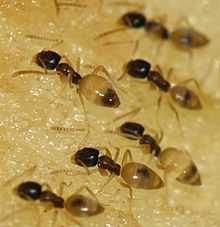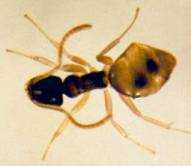Tapinoma melanocephalum
| Ghost ant | |
|---|---|
 | |
| Workers feeding on apple | |
| Scientific classification | |
| Kingdom: | Animalia |
| Phylum: | Arthropoda |
| Class: | Insecta |
| Order: | Hymenoptera |
| Family: | Formicidae |
| Genus: | Tapinoma |
| Species: | T. melanocephalum |
| Binomial name | |
| Tapinoma melanocephalum (Fabricius, 1793) | |
| Subspecies | |
| |
| Synonyms | |
| |
Tapinoma melanocephalum is a species of ant that goes by the common name ghost ant. They are recognised by their dark head and pale or translucent legs and gaster (abdomen). This colouring makes this tiny ant (1⁄16 of an inch, 1.5 mm) seem even smaller.
Description

The ghost ant is small, with average lengths ranging between 1.3 to 2.0 millimetres (0.051 to 0.079 in) in workers.[1] The antennae composes of 12 segments that thickens towards the tip.[2] The Antennal scapes exceeds the occipital border. The head and thorax is a dark brown colour while the gaster, legs and antennae are a milky white colour.[2][1] Due to its small size and light colour, the ghost ant is difficult to see.[3] Ghost ants are monomorphic and the thorax is spineless.[2] The gaster is hairless, and has a back opening that is similar to a slit-like opening.[3] The abdominal pedicel is formed upon a single segment that is usually unable to be seen due to the gaster, and the species do not contain a sting.[2]
The queens are similar in appearance to a worker, but the alitrunk (mesosoma) is enlarged. The queen measures 2.5 millimetres (0.098 in) in length, making them the largest member of the colony. The males head and dorsum is dark in colour, while the gaster is light in that may contain several dark marks. They are usually 2.0 millimetres (0.079 in) in length.[1]
Distribution and habitat
Due to how widespread the ghost ant is, the exact native range is not exactly known.[4] However, the species is assumed to originate from the African or Oriental regions, seeing it is a tropical species.[5] This has been proven considering the ghost ant cannot adapt to colder climates and are only confined to greenhouses and buildings that provide considerable conditions that allows the species to thrive, although a colony of ghost ants was discovered in an apartment block in Canada.[6] One report has even stated the presence of ghost ants in isolated regions, with a colony being found in the Galapagos Islands.[7] The ant is found in 154 geographical areas.[8]
The species is a common pest in the United States, particularly in the states of Hawaii and Florida, although the species is expanding further north, even reaching Texas by the mid 1990s.[9] They are commonly found in the southern parts of Florida, and is considered a key pest, along with several other invasive ant species.[10] The earliest record of the ghost ant in the United States was in 1887, where the species was found in Hawaii.[11] It was then recorded in Washington, D.C. in 1894.[12] After these two records, the ghost ant would later be found in Maine, New York, Connecticut, Virginia, North Carolina, Georgia, Florida, Illinois, Michigan, Wisconsin, Minnesota, Iowa, Missouri, Louisiana, Texas, Kansas, New Mexico, Arizona, California, Oregon and Washington.[8][13] Ghost ants can be found in the U.S. territories of Puerto Rico and the U.S. Virgin Islands.[14]
Pest control
One laboratory evaluation in 1996 [15] tested 1% boric acid in a sucrose solution, against a few ant species including ghost ants. With a three-day continuous exposure to boric acid, the number of ghost ant workers was reduced by 97% and by the 8th week all ghost ant queens were eliminated. Interestingly they found that with hydramethylnon (an active ingredient in a ready to use bait) none of the ghost ant colonies were eliminated.
A new development in the U.K is that the availability of some concentrates has been phased out due to the influence of the European legislation such as the Biocide Directive. The ant has another, less often used, common name, "tiny yellow house ant". In Malaysia they are known as "corpse ants" because of the unpleasant odour they secrete when crushed. The ghost ant's diet consists mainly of sweets but they will also feed on grease and occasionally living or dead insects. They exhibit a high need for moisture, and although colonies are usually established outside, they can readily "set up camp" inside domestic houses during dry conditions.
This is a widespread tropical species, found throughout the world. Its native range is unknown. The ghost ant is thought to be so named because the legs and abdomen of the insect look transparent, with only the head and thorax being dark brown in colour. Observed in infested buildings with the naked eye they are quite difficult to distinguish from pharaoh ants, being virtually of the same size. Like a lot of small insects a positive identification can only be made once is a specimen is looked at through a microscope. The worker ants form trails like pharaoh ants, taking food back to the nest, and also like pharaoh ants, the queens are communal, so that there can be several queens in a colony, and several thousand workers. New colonies can be formed when a queen and some workers migrate away.
References
- ↑ 1.0 1.1 1.2 Collingwood, C.A. (1979). "The Formicidae (Hymenoptera) of Fennoscandia and Denmark" (PDF). Fauna Entomologica Scandinavica 8: 1–174. Retrieved 5 February 2015.
- ↑ 2.0 2.1 2.2 2.3 Creighton, W.S. (1950). "The ants of North America" (PDF). Bulletin of the Museum of Comparative Zoology of Harvard College 104: 1–585. Retrieved 5 February 2015.
- ↑ 3.0 3.1 Smith, Eric H.; Whitman, Richard C. (1992). NPCA Field Guide to Structural Pests. Dunn Loring, Virginia: National Pest Control Association.
- ↑ Smith, Marion R. (1965). "House-infesting ants of the eastern United States : their recognition, biology, and economic importance". Technical bulletin no. 1326. (Washington, D.C.: United States Department of Agriculture): 72. OCLC 6078460. Retrieved 31 December 2014.
- ↑ Wheeler, William M. (1910). "Ants; their structure, development and behavior". Columbia biological series (New York, Columbia University Press) 9: 578–648. doi:10.5962/bhl.title.1937. OCLC 560205. Retrieved 6 February 2015.
- ↑ Ayre, G.L. (1977). "Exotic ants in Winnipeg, Manitoba". Entomologist 11: 4111–4144.
- ↑ Clark, David B.; Guayasamin, Concepcion; Pazmino, Olga; Donoso, Cecilia; de Villacis, Yolanda Paez (September 1982). "The Tramp Ant Wasmannia auropunctata: Autecology and Effects on Ant Diversity and Distribution on Santa Cruz Island, Galapagos" (PDF). Biotropica 14 (3): 196. doi:10.2307/2388026. Retrieved 6 February 2015.
- ↑ 8.0 8.1 Wetterer, James K. (2012). "Worldwide spread of the ghost ant, Tapinoma melanocephalum (Hymenoptera: Formicidae)". Myrmecological News 12: 23–33. Retrieved 6 February 2015.
- ↑ Chenault, E.A. (1997). "Ghost ants now in Texas". Texas AgriLife Research News. Retrieved 6 February 2015.
- ↑ Klotz, J.H.; Mangold, J.R.; Vail, K.M.; Davis Jr, L.R.; Patterson, R.S. (1995). "A survey of the urban pest ants (Hymenoptera: Formicidae) of peninsular Florida". Florida Entomologist 78 (1): 109–118. doi:10.2307/3495674.
- ↑ Blackburn, T; Cameron, P. (1887). "On the Hymenoptera of the Hawaiian Islands". Memoirs of The Manchester Literary And Philosophical Society 10: 194–244.
- ↑ Pergande, Theo (1896). "Mexican Formicidae". Proceedings of the California Academy of Sciences 5 (2): 858–896.
- ↑ King, R.L. (1948). "A tropical ant temporarily established in Iowa". Proceedings of the Iowa Academy of Science 55: 395.
- ↑ Forel, Auguste H. (1881). "Die Ameisen der Antille St. Thomas". Mitteilungen der Münchener Entomologischen Verein 5: 1–16.
- ↑ Klotz, John (1996). "Laboratory evaluation of boric acid liquid bait on colonies of Tapinoma melanocephalum, Argentine Ants and Pharaoh Ants". Journal of Economic Entomology 89 (3): 673–677. doi:10.1093/jee/89.3.673.
External links
| Wikimedia Commons has media related to Tapinoma melanocephalum. |
- Tapinoma melanocephalum on the UF / IFAS Featured Creatures Web site